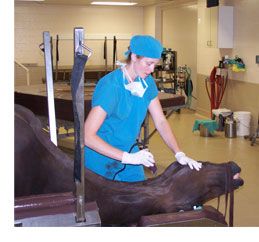9 steps to a great equine surgery
Equine surgical veterinary technicians, like Boy Scouts, learn to be prepared.

Equine surgical technicians at Hagyard Equine Medical Institute recently shared the typical steps in their equine surgery routine. If you work on small animals, compare your surgical steps to the work of these large-animal team members.
Before surgery
1. Make sure the room is clear and damp-dusted, so that anything that might potentially contaminate the room during the 24 hours prior to surgery is gone.
2. Verify that the equipment and the patient are ready. Any surgical instruments and electrical equipment that will be needed should be ready and in the room before the procedure begins.
3. Check that the surgical table, the hydraulics, and the hoist are in working order.
4. Perform pre-surgery radiographs on the horse, as needed.
5. Scrub the horse for catheterization, and insert the catheter.
6. Double-check the induction routine and the amount of drugs to be administered. When we 'drop' the horse the vet's there to assist us.
7. Hoist the horse onto the table and prep for surgery.
During surgery
8. Anticipate and respond to veterinarians' requests for various items. Be familiar with the preferences for particular materials or procedures of individual veterinarians.
After surgery
9. Anticipate recovery time, typically between 20 to 40 minutes. Recovery after a chondylar fracture repair, for rexample, takes about 45 minutes minutes for the patient to be standing and ready to go back to the stall. For quicker procedures, like arthroscopy, castration, or soft-tissue surgery, patients are usually up in 20 to 30 minutes.
Click here to learn more about a day in the life of these equine technicians.
Ed Kane, PhD, is a researcher and consultant in animal nutrition. He is an author and editor on nutrition, physiology and veterinary medicine with a background in horses, pets and livestock. Kane is based in Seattle.